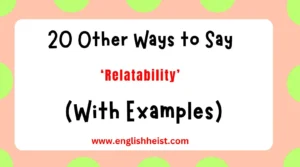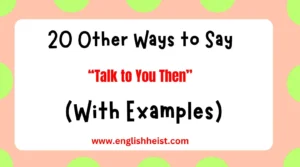Whether you’re hosting a party, planning a meeting, or organizing an event, telling guests that food will be served can be done in many creative and engaging ways. The goal is to not just convey the message, but to make it feel inviting and exciting.
Below are 20 alternative ways to say “Food will be served,” with examples, so you can add a bit more flavor to your language!
What Does “Food Will Be Served” Mean?
“Food will be served” is a straightforward phrase used to inform people that there will be food available at a gathering or event.
It’s often used to ensure that guests know they will be taken care of in terms of meals, making them feel more comfortable and welcome.
Is It Professional/Polite to Say “Food Will Be Served”?
Yes, “food will be served” is both professional and polite in most contexts, especially when you are hosting or coordinating an event.
However, for more formal events, you may want to elevate the language or be more specific about the meal offerings to create a more sophisticated atmosphere.
Pros and Cons of Saying “Food Will Be Served”
Pros:
- Direct and simple
- Works in most casual and semi-formal contexts
- It clearly informs guests that food is part of the event
Cons:
- Can feel too plain or generic
- Might lack enthusiasm or excitement
- Doesn’t offer much detail about the food experience
Main Points:
- Clear Communication: This phrase communicates the basic idea of food availability.
- Casual: It works best for less formal occasions.
- Lack of Detail: It doesn’t describe the type or quality of food.
Synonyms For “Food Will Be Served”
- A Delicious Spread Awaits You!
- Dinner is On Us!
- Feast Your Eyes and Your Stomach!
- A Meal Fit for a King Awaits!
- Supper is Served!
- Your Meal is Ready!
- Dinner Has Been Prepared!
- Time to Eat!
- Come and Get It!
- Dinner is Ready to Be Enjoyed!
- A Tasty Feast Awaits You!
- Let’s Eat!
- Meal Time!
- The Table is Set!
- Get Ready for a Great Meal!
- Dine in Style!
- The Feast Begins!
- Ready, Set, Eat!
- Dinner Is Served with Love!
- Indulge in a Wonderful Meal!
1. A Delicious Spread Awaits You!
Scenario: Inviting guests to a casual dinner or buffet.
- Example 1: “A delicious spread awaits you—come hungry!”
- Example 2: “Get ready, a delicious spread is waiting for you!”
- Example 3: “A fantastic spread is about to be served!”
Best Use: Ideal for informal or casual gatherings.
Tone: Excited, inviting.
Explanation: This phrase makes the meal sound like an enjoyable experience, creating anticipation.
2. Dinner is On Us!
Scenario: Offering a meal at a casual event or social gathering.
- Example 1: “Dinner is on us tonight, enjoy!”
- Example 2: “Don’t worry about dinner, it’s on us!”
- Example 3: “Dinner’s ready and it’s on us!”
Best Use: Perfect for informal gatherings where you’re hosting a meal for others.
Tone: Generous, casual.
Explanation: It emphasizes that guests can relax and enjoy the meal without worry, with a personal touch.
3. Feast Your Eyes and Your Stomach!
Scenario: Introducing a large and elaborate spread at a celebration.
- Example 1: “Feast your eyes and your stomach on this amazing spread!”
- Example 2: “We’ve got a feast waiting for you to enjoy!”
- Example 3: “Feast your eyes first, then feast your stomach!”
Best Use: Great for fun, lively events like celebrations or parties.
Tone: Playful, energetic.
Explanation: Adds a sense of excitement and fun, highlighting both the visual and culinary appeal of the food.
4. A Meal Fit for a King Awaits!
Scenario: Offering a gourmet or extravagant meal at a formal or semi-formal event.
- Example 1: “A meal fit for a king awaits you—prepare to be amazed!”
- Example 2: “A royal feast is waiting for you!”
- Example 3: “You’re in for a treat, a meal fit for royalty is ready!”
Best Use: For elegant, luxurious events.
Tone: Formal, lavish.
Explanation: This phrase adds an air of sophistication and grandeur, perfect for high-end gatherings.
5. Supper is Served!
Scenario: Announcing the meal at a family dinner or small gathering.
- Example 1: “Supper is served, everyone come and eat!”
- Example 2: “It’s supper time, let’s all dig in!”
- Example 3: “Supper’s ready, come join us!”
Best Use: Casual, cozy gatherings, often at home.
Tone: Casual, inviting.
Explanation: This phrase is simple and warm, typically used in a home setting where the atmosphere is relaxed and intimate.
6. Your Meal is Ready!
Scenario: Letting guests know that food is prepared and ready to be served.
- Example 1: “Your meal is ready, please help yourself!”
- Example 2: “The meal is ready to go, come and get it!”
- Example 3: “Your meal is ready, enjoy!”
Best Use: Ideal for casual settings, such as a home dinner or a small gathering.
Tone: Simple, welcoming.
Explanation: A clear and straightforward announcement that the meal is ready.
7. Dinner Has Been Prepared!
Scenario: After a cooking session or for a formal gathering where the meal is being presented.
- Example 1: “Dinner has been prepared and is waiting for you!”
- Example 2: “Your dinner has been lovingly prepared!”
- Example 3: “Dinner is prepared and waiting—enjoy!”
Best Use: For both casual and semi-formal occasions.
Tone: Warm, inviting.
Explanation: This phrase conveys that the food has been made with care, adding a personal touch.
8. Time to Eat!
Scenario: A simple and direct way to announce that the meal is ready.
- Example 1: “Time to eat! Hope you’re hungry!”
- Example 2: “It’s time to eat—let’s go!”
- Example 3: “Alright, time to eat—dig in!”
Best Use: Ideal for informal settings or when the meal is ready to be enjoyed right away.
Tone: Casual, energetic.
Explanation: This phrase is direct and gets to the point, perfect when you want to gather everyone quickly.
9. Come and Get It!
Scenario: Inviting guests to come to the table and enjoy the meal.
- Example 1: “Come and get it—dinner is served!”
- Example 2: “Dinner’s ready, come and get it!”
- Example 3: “It’s time—come and get it!”
Best Use: For a relaxed, fun event where everyone is excited about the food.
Tone: Playful, casual.
Explanation: This phrase adds excitement and energy to the mealtime announcement.
10. Dinner is Ready to Be Enjoyed!
Scenario: A formal or semi-formal dinner event.
- Example 1: “Dinner is ready to be enjoyed—please take your seat!”
- Example 2: “Your dinner is ready, it’s time to indulge!”
- Example 3: “Please join us—dinner is ready to be enjoyed!”
Best Use: For more formal events or dinners.
Tone: Polite, formal.
Explanation: This phrase makes the meal sound more refined and thoughtful, setting the tone for a formal event.
11. A Tasty Feast Awaits You!
Scenario: For a gathering with an impressive spread.
- Example 1: “A tasty feast awaits you—enjoy every bite!”
- Example 2: “Come hungry, a tasty feast is waiting!”
- Example 3: “The feast is ready, let’s eat!”
Best Use: For casual to semi-formal events with an elaborate spread.
Tone: Excited, friendly.
Explanation: This adds a sense of anticipation for the delicious meal ahead.
12. Let’s Eat!
Scenario: After a meal has been set, ready for everyone to dive in.
- Example 1: “Let’s eat, everyone—dinner’s ready!”
- Example 2: “Okay, let’s eat!”
- Example 3: “Let’s eat! We’ve got a great meal ahead!”
Best Use: Casual, home-based events or dinners.
Tone: Relaxed, direct.
Explanation: A friendly, no-frills way to let people know the meal is ready and it’s time to dig in.
13. Meal Time!
Scenario: A simple and upbeat way to announce the meal.
- Example 1: “Meal time, come on in!”
- Example 2: “It’s meal time—time to eat!”
- Example 3: “Meal time, hope you’re hungry!”
Best Use: Casual settings or family meals.
Tone: Friendly, energetic.
Explanation: A cheerful, welcoming phrase that gets people excited for the meal.
14. The Table is Set!
Scenario: Announcing that the food is ready and everything is prepared.
- Example 1: “The table is set, let’s eat!”
- Example 2: “Everything is ready—the table is set for you!”
- Example 3: “Come and sit, the table is set!”
Best Use: Ideal for formal or semi-formal meals.
Tone: Polite, formal.
Explanation: This phrase is great for when you want to highlight the effort put into the meal setup.
15. Get Ready for a Great Meal!
Scenario: Announcing that food is about to be served in a fun and exciting way.
- Example 1: “Get ready for a great meal, it’s about to begin!”
- Example 2: “Get ready for a delicious treat—your meal is served!”
- Example 3: “Get ready for a great meal, let’s eat!”
Best Use: Casual or semi-formal events.
Tone: Enthusiastic, friendly.
Explanation: This phrase sets an exciting tone and builds anticipation for the upcoming meal.
16. Dine in Style!
Scenario: For a formal dinner or classy event.
- Example 1: “Dine in style—your meal is ready!”
- Example 2: “It’s time to dine in style!”
- Example 3: “Dine in style tonight—come enjoy your meal!”
Best Use: For elegant, sophisticated gatherings.
Tone: Formal, refined.
Explanation: This phrase elevates the dining experience, making it sound exclusive and high-end.
17. The Feast Begins!
Scenario: Announcing the start of an elaborate meal.
- Example 1: “The feast begins—enjoy!”
- Example 2: “The feast begins—come join us!”
- Example 3: “Let the feast begin, everyone!”
Best Use: For celebrations, parties, or large family meals.
Tone: Dramatic, celebratory.
Explanation: A more enthusiastic and dramatic way to introduce the meal, perfect for big events.
18. Ready, Set, Eat!
Scenario: A playful, casual way to announce that the meal is ready.
- Example 1: “Ready, set, eat—dinner is served!”
- Example 2: “Alright, ready, set, eat!”
- Example 3: “Ready, set, go—dinner’s ready!”
Best Use: Informal, fun gatherings.
Tone: Playful, energetic.
Explanation: This adds a sense of fun and excitement to the meal announcement.
19. Dinner Is Served with Love!
Scenario: Announcing a homemade meal to guests with care.
- Example 1: “Dinner is served with love—enjoy!”
- Example 2: “Dinner’s ready and served with love!”
- Example 3: “We’ve made dinner with love, enjoy every bite!”
Best Use: For intimate or homey gatherings where you want to convey care.
Tone: Warm, heartfelt.
Explanation: This phrase adds a personal touch, showing that the meal was prepared with care.
20. Indulge in a Wonderful Meal!
Scenario: Inviting guests to enjoy an indulgent, sumptuous meal.
- Example 1: “Indulge in a wonderful meal, it’s ready!”
- Example 2: “Time to indulge in a great meal!”
- Example 3: “Indulge in this fantastic meal prepared just for you!”
Best Use: For a special or indulgent meal, like a holiday feast or fine dining experience.
Tone: Elegant, inviting.
Explanation: This phrase encourages guests to truly savor and enjoy the meal ahead.
Conclusion
The way you announce food can set the tone for the entire dining experience. Whether you’re hosting a formal dinner, a casual get-together, or a lively celebration, the right phrase can make your message more engaging, inviting, and warm.
Instead of the usual “Food will be served,” try using one of these 20 creative alternatives to make your guests feel excited, welcomed, and appreciated.

Mia Rose is your go-to platform for mastering the English language. Through clear, concise lessons and expert advice, Mia makes learning grammar, vocabulary, and writing skills easy and enjoyable. Whether you’re a beginner or looking to refine your skills, English Heist helps you communicate confidently and effectively.













